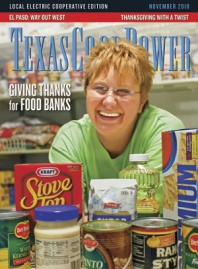Power Angels
I am handicapped, getting a small monthly check from Social Security disability. In November of 2009, I bought an old mobile home and moved it to Kempner, in the Hamilton County Electric Cooperative service area. For the first two months, I had to live in my van. People at Hamilton County Electric expressed caring and kindness to me and worked with me on the deposit and during months when money was tight. Thank you— you’ve made me feel like family.
Roger Bishop, Hamilton County Electric Cooperative
Unsung Friday Night Heroes
Thanks for your article on our often unsung Friday night heroes–band kids! (September 2010) There’s nothing quite like band in Texas, and Charles Boisseau has captured it pretty well. Kudos to him for telling readers that band students learn life lessons and for citing research that ties the study of music to success in school.
When I sat down to read your article, I had just arrived home from a day spent at a high school marching band contest where I watched hundreds of committed, hardworking student musicians put their programs on the field. There was a remarkable cast of characters behind every band there, from directors, to parents, to young student helpers, to community supporters, to the state’s music education leaders who lobby tirelessly to keep music and the other fine arts part of the Texas curriculum.
Thanks again for an excellent article, and, as always, GO BAND!
Trish Howard, Medina Electric Cooperative
Wooden Nickels Bring a Smile
When I opened the September 2010 issue of Texas Co-op Power, a grin as big as all Texas spread across my face thanks to Susan Petty and her “Nickel’s Worth of Memories” letter about the story on roller-skating rinks in the June issue.
I, too, skated at Deuback’s rink as a child on Saturdays, after my friends and I had been to the kiddie shows at the Granada theater on lower Greenville. And, yes, I skated backward wearing my beautiful white boot skates I was given for my birthday. We also had relay races on skates. What wonderful childhood memories!
Thank you for your wonderful wealth of information in the magazine and bringing back memories to us baby boomers.
Beverly Zimmerman, Pedernales Electric Cooperative
Bullish on College Rodeo
I really appreciated your story on college rodeo (“Rope Courses,” August 2010). You have written about one of the most difficult parts of collegiate rodeo; that is, making some cash. It’s been very difficult to make some large university leaders understand how rodeo, and particularly how prize money (even if it’s just a jackpot), enters into a college sport. The money involved certainly hasn’t corrupted the athletes. All we need now is to promote the team concept and not so much the individual. As I have been in radio and television marketing all my life, I realize this has been lacking. More exposure for college teams is definitely needed! Thanks again for your story.
Charlie Rankin, Fair Oaks Ranch
Editor’s note: While a student at Texas A&M University in the late 1940s, Rankin was one of the founders of the National Intercollegiate Rodeo Association and served as the organization’s first president.
Correcting Caddo Lake Information
A travel article in the September 2010 issue incorrectly states that Caddo Lake is “the only natural lake in Texas.” This is a widely held misconception and repeats an error that appeared in a November 2008 story about Caddo Lake and efforts to protect it against destructive giant salvinia.
Caddo Lake is Texas’ largest natural freshwater lake. However, there are many natural lakes in Texas, from small to large. The largest is Sabine Lake into which the Sabine and Neches rivers discharge before it empties into the Gulf of Mexico through Sabine Pass (Orange/Jefferson counties). Thus, Caddo Lake is the second largest lake; however, although originally a natural swamp lake, its surface area and capacity have been increased by the construction of dams. Third is Green Lake in Calhoun County. Then, in East Texas, there are many small oxbow or horseshoe lakes as well as along the Rio Grande where they are called resacas. Finally, there are numerous playa lakes scattered throughout the High Plains and South Plains.
Ray C. Telfair II, Ph.D., Certified wildlife biologist by The Wildlife Society, Cherokee County Electric Cooperative
Newspapers and Ice
I really enjoyed Clay Coppedge’s article “An Era Frozen in Time” (August 2010). Back in the ’50s I had a red Allstate scooter that I used to deliver the three San Antonio newspapers to customers in Marion. One of my customers was Ms. Emmie Kailer. I believe she lived in what used to be the old post office. She had one of the old iceboxes that utilized a block of ice in an enclosed area on top, and the food items were kept cold in the enclosed area below. About once a week, she would ask me to go to Reeder’s Ice House at the east end of Marion to purchase about a half block of ice for her for 25 cents. For delivering the ice, I was paid 25 cents also. It was a real treat to go to Reeder’s Ice House and go inside the ice storage vault, especially during the summer when it was very hot. They also sold ice cream at Reeder’s so we’d buy an ice cream and then go inside so it wouldn’t melt as quickly.
Great memories …
Jim Schulz, Schertz


